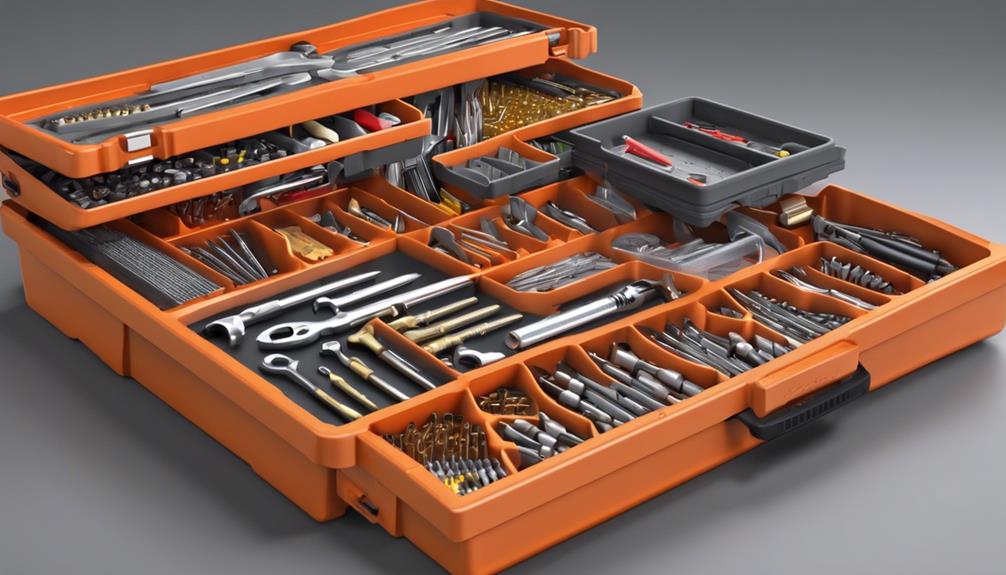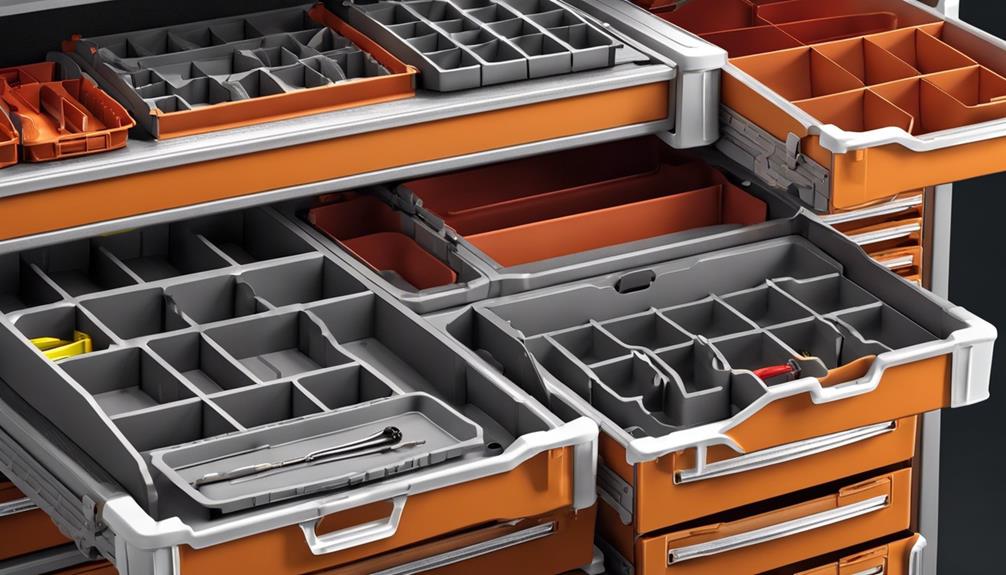An organizer tray for your tool box is a game-changer. It boosts efficiency by keeping your tools in place, saving time and maximizing your toolbox's space with custom compartments. Choose one made from sturdy materials like ABS plastic or metal that fits snugly. Confirm compartments suit your tools and check for tough edges. Categorize your tools by type and usage frequency, label them, and use drawer dividers. Regular cleanups with a basic toolkit containing a brush, rag, lubricating oil, and rust remover will prolong tool life. These trays will make your work area a well-oiled machine.
Key Takeaways
- Choose a tray with customizable compartments to fit various tools.
- Look for a stackable design to optimize space in the toolbox.
- Opt for a portable tray with handles for easy transportation.
- Consider a tray with durable materials like ABS plastic for longevity.
- Select a tray that snugly fits in your toolbox for efficient organization.
Benefits of Using an Organizer Tray

To sum up, initially, an organizer tray in your tool box can greatly enhance efficiency and organization when working on projects. The benefits of utilizing an organizer tray are numerous. It saves you time by providing a designated spot for each tool, allowing you to quickly locate what you need without rummaging through a cluttered toolbox. This time-saving feature is invaluable, especially when working on time-sensitive projects or in situations where every minute counts.
Moreover, an organizer tray helps maximize space within your toolbox. By neatly arranging your tools in a tray, you create more room for additional items, preventing overcrowding and ensuring that each tool has its own place. This space-maximizing quality not only improves organization but also makes it easier to transport your toolbox without the fear of tools shifting around and getting damaged.
Additionally, organizer trays are typically made from durable materials such as high-quality plastic or metal, ensuring longevity and withstanding the wear and tear of regular use. The sturdy construction of these trays means that they can endure the weight of heavy tools without warping or breaking, providing a reliable storage solution for your tools.
Types of Organizer Trays Available
You can find a variety of organizer trays designed to suit different tool storage needs and preferences. When looking for the right organizer tray, consider customizable options that allow you to adjust the compartments according to your tools' sizes.
Stackable designs are also available, enabling you to maximize space in your tool box by stacking multiple trays on top of each other.
For those who need portability, there are organizer trays with handles or carrying cases that make transporting your tools easier. These portable solutions are ideal for professionals who need to bring their tools to different job sites.
Drawer inserts are another popular type of organizer tray that fit neatly into the drawers of your tool box, keeping everything organized and easily accessible.
Some trays come with adjustable dividers that can be moved to create the perfect layout for your tools. Others have transparent lids, allowing you to quickly see the contents without opening the tray.
Consider your specific needs and the type of tools you have when choosing the right organizer tray for your tool box.
How to Choose the Right Tray

Consider key factors such as your tool collection size and storage needs when selecting the right tray for your tool box. The tray material plays an important role in determining the longevity of the organizer. Opt for trays made from durable materials like ABS plastic or metal for enhanced durability. Plastic trays are lightweight and resistant to rust, while metal trays offer superior strength.
Tray size is another essential aspect to contemplate. Choose a tray that fits snugly into your tool box while still providing enough room for your tools. Make sure the dimensions of the tray align with the interior of your tool box to maximize space efficiency.
When evaluating tray compartments, think about the variety of tools you possess. Select a tray with compartments that can accommodate different tool sizes adequately. Adjustable dividers can be beneficial for customizing the layout based on your specific tools.
Durability is paramount for a tray that will withstand the rigors of daily use. Look for trays with reinforced edges and sturdy construction to prevent cracking or breaking over time. A robust tray will ensure your tools stay organized and secure for an extended period.
Tips for Organizing Your Tools
Organizing your tools efficiently starts with categorizing them based on their types and frequency of use. One effective tip for organizing your tools is to use tool labeling. Labeling your tools can save you valuable time and effort by making it easy to identify and locate the right tool for the job. Consider using a label maker or adhesive labels to clearly mark each tool's designated spot.
Another useful tip is to utilize drawer dividers in your tool chest. Drawer dividers help keep your tools separated and organized, preventing them from getting jumbled together. You can find adjustable dividers that allow you to customize the layout of your drawers based on the sizes of your tools. This can help maximize space and make certain that each tool has its own designated space.
When organizing your tools, think about the frequency of use. Keep frequently used tools within easy reach, while storing less commonly used ones in a separate section. This will help streamline your workflow and make it more convenient to access the tools you use most often.
Maintenance and Cleaning Tips

Regular maintenance and cleaning of your tools is essential to guarantee their longevity and peak performance. To keep your tools in top shape, it's important to have the right cleaning supplies on hand. A basic toolkit for cleaning should include items such as a stiff brush, a rag, lubricating oil, and a rust remover.
Cleaning your tools regularly helps prevent rust, which can greatly reduce their lifespan. After each use, wipe down your tools with a clean rag to remove any dirt, dust, or moisture. For stubborn grime, use a brush to scrub the surface gently. Make sure to dry your tools thoroughly after cleaning to prevent any water from causing rust.
When it comes to preventing rust, storing your tools properly is key. Consider investing in a dehumidifier for your tool storage area to reduce moisture levels. Additionally, applying a thin coat of lubricating oil to metal parts can help create a barrier against moisture and oxygen, reducing the chances of rust formation.
Inspect your tools regularly for any signs of rust or corrosion. If you notice any, use a rust remover following the manufacturer's instructions to clean the affected areas.
Conclusion
To sum up, using an organizer tray for your tool box can greatly improve efficiency and organization in your workspace. With various types available to suit your needs, selecting the right tray is essential for maximizing its benefits.
By following some simple tips for organizing and maintaining your tools, you can guarantee that your workspace remains tidy and clutter-free. Invest in an organizer tray today and experience the difference it can make in your workflow.
